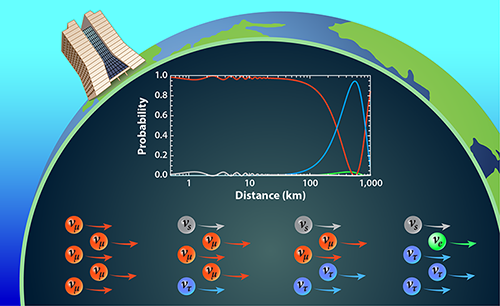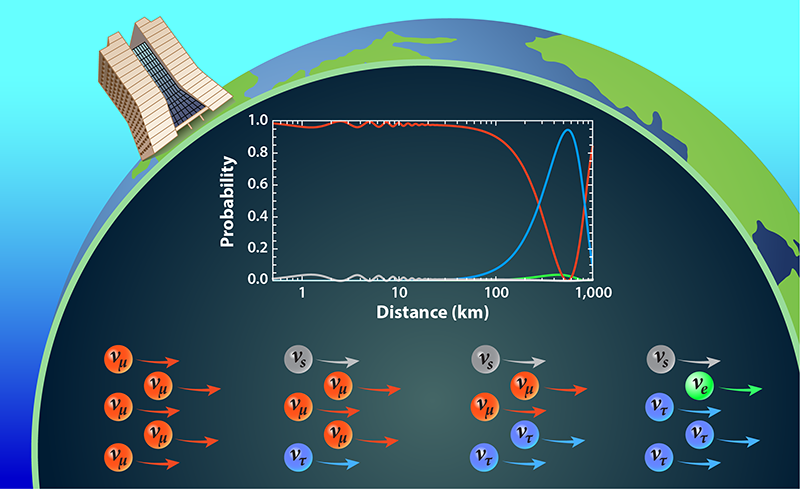Sterile Neutrino Down but Not Completely Out
Physicists know a lot about neutrinos. These elementary particles exist everywhere yet rarely interact with matter. They are produced in three different types—electron, muon, and tau—known in the field as flavors. And they can oscillate between these flavors, periodically changing from one to another as they travel. But despite this knowledge, neutrinos are shrouded in some big mysteries. For example, that neutrinos oscillate implies that at least two of the particles have a nonzero mass, but the exact mass has yet to be determined (oscillation experiments provide only information on the squared mass difference between neutrinos, and cosmological experiments are sensitive only to the sum of all three masses). Additionally, experiments hint at the existence of an enigmatic fourth neutrino, called the sterile neutrino (see Viewpoint: The Plot Thickens for a Fourth Neutrino). But the results are controversial, and the signals from this particle are inconsistent (see Viewpoint: Getting to the Bottom of an Antineutrino Anomaly, and Viewpoint: Hunting the Sterile Neutrino). Now the collaborations behind the MINOS and MINOS+ experiments at Fermilab in the US and the Daya Bay Reactor Neutrino Experiment in China have released an analysis that eliminates a large portion of the remaining parameter space in which sterile neutrinos could exist [1]. But the teams have not yet studied all their data, and other experiments do see possible signals, leaving the door ajar for the existence of this disputed particle.
The oscillation of neutrinos between flavors is a quantum effect. It comes from the fact that each neutrino flavor, 𝜈e (electron), 𝜈𝜇 (muon), and 𝜈𝜏 (tau), is a linear superposition of three states, 𝜈1, 𝜈2, and 𝜈3 with masses m1, m2, and m3 (see Focus: Nobel Prize—Neutrinos Oscillate). Precision measurements show that the distance it takes for one neutrino to turn into another—the neutrino oscillation baseline—depends on the energies of the participating states and the difference between their squared masses. For example, a 1-GeV muon neutrino from the neutrino beam at Fermilab typically takes 500 km to oscillate into a tau neutrino. A 3-MeV electron antineutrino from a nuclear reactor, on the other hand, takes only 1 km to switch flavors. Both oscillations are consistent with Δm231=m23−m21=2.5×10−3eV2.
However, some experiments have found a number of puzzling results that don’t fit with the three-neutrino framework. The oldest of these results comes from the Liquid Scintillator Neutrino Detector (LSND) experiment at Los Alamos National Laboratory, where in 2001 they obtained data consistent with muon antineutrinos converting into electron antineutrinos over shorter distances than expected for three-flavor neutrino oscillations [2]. Later, the Mini Booster Neutrino Experiment (MiniBooNE), which was built to test the LSND anomaly, observed a similar signal [3].
One explanation for these short oscillations is that there exists a fourth “sterile” neutrino, 𝜈s, which does not interact via any of the fundamental interactions of the standard model of particle physics. The LSND and MiniBooNE data suggest that such a particle would have oscillations with a mass splitting of Δm241=1eV2. Other results from some reactor neutrino experiments also fit with a 1-eV2 mass splitting or more [4]. The new analysis from the MINOS, MINOS+, and Daya Bay collaborations, which includes old data from Bugey-3—an experiment that ended in 1996—searched for signals with these mass splittings. But the teams found no hints of sterile neutrinos where other experiments have seen one.
MINOS and MINOS+ are long-baseline experiments, where the neutrinos travel hundreds of kilometers before they are detected. The two experiments study the disappearance of muon neutrinos produced at Fermilab using detectors placed 1.04 km and 735 km from the lab [5]. Daya Bay is a medium-baseline experiment. Their electron antineutrinos are produced at six nuclear reactors and detected with eight antineutrino detectors that are in three different underground halls, which are at distances ranging from 365 m to 1.9 km from the reactor [6]. Bugey-3 was a short-baseline experiment that detected muon neutrino oscillations at distances of 15, 40, and 95 m from the reactor core, where the neutrinos were produced.
Analyzing their combined data, the collaborations have been able to set new constraints on the probability that the muon neutrino oscillates into an electron neutrino via a sterile one over these distances. They eliminate the sterile neutrino region of interest for mass splittings between 10−4 to 103 eV2.
These new constraints exacerbate tension surrounding the sterile neutrino. This tension comes because they exclude mass splittings values for sterile neutrino signals that could explain both the early LSND and MiniBooNE experiments [7] and also in new unpublished MiniBooNE experiments that analyze a 17-year-long dataset [8]. Other unpublished results, this time from the IceCube Collaboration, which analyzes eight years of atmospheric muon neutrino data, also question the existence of a sterile neutrino [9]. And the absence of a sterile neutrino fits with data from the Planck satellites that measure the energy density of the early Universe [10].
These conflicts mean that additional data are still needed to resolve the sterile neutrino problem, particularly from the Short Baseline Neutrino Program at Fermilab. Moreover, the MINOS+ Collaboration still has to analyze the last year of data from their experiments and the Daya Bay Collaboration has two additional years of data-taking to look at. That further data could provide valuable evidence in favor of or against the existence of sterile neutrinos.
References
- P. Adamson et al. (MINOS+ and Daya Bay Collaborations), “Improved constraints on sterile neutrino mixing from disappearance searches in the MINOS, MINOS+, Daya Bay, and Bugey-3 experiments,” Phys. Rev. Lett. 125, 071801 (2020).
- A. Aguilar et al. (LSND Collaboration), “Evidence for neutrino oscillations from the observation of ̄𝜈e appearance in a ̄𝜈𝜇 beam,” Phys. Rev. D 64, 112007 (2001).
- A. A. Aguilar-Arevalo et al. (MiniBooNE Collaboration), “Significant excess of electronlike events in the MiniBooNE short-baseline neutrino experiment,” Phys. Rev. Lett. 121, 221801 (2018).
- G. Mention et al., “Reactor antineutrino anomaly,” Phys. Rev. D 83, 073006 (2011); P. Huber, “Determination of antineutrino spectra from nuclear reactors,” Phys. Rev. C 84, 024617 (2011); P. Huber, “Erratum: Determination of antineutrino spectra from nuclear reactors [Phys. Rev. C 84, 024617 (2011)],” 85, 029901 (2012); C. Giunti and M. Laveder, “Statistical significance of the gallium anomaly,” 83, 065504 (2011).
- P. Adamson et al. (MINOS+ Collaboration), “Search for sterile neutrinos in MINOS and MINOS+ using a two-detector fit,” Phys. Rev. Lett. 122, 091803 (2019).
- F. P. An et al. (Daya Bay Collaboration), “Measurement of electron antineutrino oscillation based on 1230 days of operation of the Daya Bay experiment,” Phys. Rev. D 95, 072006 (2017); B. Achkar et al., “Search for neutrino oscillations at 15, 40 and 95 meters from a nuclear power reactor at Bugey,” Nucl. Phys. B 434, 503 (1995).
- S. Gariazzo et al., “Updated global 3+1 analysis of short-baseline neutrino oscillations,” J. High Energy Phys. 2017, 135 (2017); M. Dentler et al., “Updated global analysis of neutrino oscillations in the presence of eV-scale sterile neutrinos,” J. High Energy Phys. 2018, 10 (2018); A. Diaz et al., “Where are we with light sterile neutrinos?” arXiv:1906.00045.
- A. A. Aguilar-Arevalo et al. (MiniBooNE Collaboration), “Updated MiniBooNE neutrino oscillation results with increased data and new background studies,” arXiv:2006.16883.
- M. G. Aartsen et al. (IceCube Collaboration), “An eV-scale sterile neutrino search using eight years of atmospheric muon neutrino data from the IceCube Neutrino Observatory,” arXiv:2005.12942.
- N. Aghanim et al. (Planck Collaboration), “Planck 2018 results. VI. Cosmological parameters,” arXiv:1807.06209; S. Hagstotz et al., “Bounds on light sterile neutrino mass and mixing from cosmology and laboratory searches,” arXiv:2003.02289; J. Bergström et al., “Statistical tests of sterile neutrinos using cosmology and short-baseline data,” J. High Energy Phys. 2014, 104 (2014).





